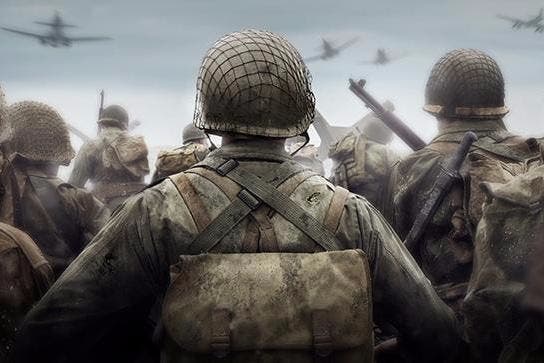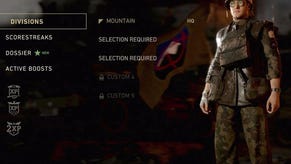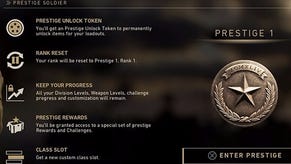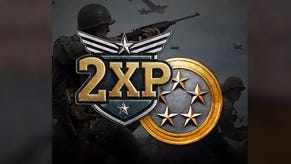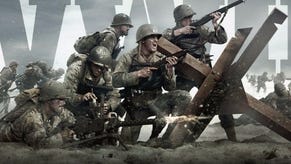How Call of Duty: WW2 handles swastikas and female soldiers
"I'll come right through the front door on it¡"
By setting the next Call of Duty in World War 2, Activision charged the developers at Sledgehammer Games with coming up with a philosophy for dealing with Nazi iconography and the possibility of playing as non-German male soldiers when the game puts players on the Axis side in multiplayer.
Sledgehammer's approach was to treat the campaign very different than the multiplayer side of the game.
In an E3 interview with Eurogamer, Sledgehammer Games co-founder Michael Condrey told me swastikas will appear in Call of Duty: WW2's campaign, but won't be present in multiplayer.
And, he added, non-white male soldiers will be playable on the Axis side of multiplayer - despite this not being authentic to the time period.
Explaining the decision, Condrey said Call of Duty: WW2's campaign is about telling an authentic World War 2 story, whereas multiplayer is about putting the player's avatar, whatever it may be, inside a World War 2-themed shooter.
"The campaign in this game is about finding that line of quality entertainment with respect for the world's greatest conflict and the people who sacrificed and died," Condrey said. "We tell that narrative in a way we think honours the cause.
"Multiplayer is about bringing a community together that enjoys playing Call of Duty. It's faster. There's a brutality to WW2 multiplayer that is different than the last few games we made, but we were able to take some creative liberties to make that an experience multiplayer fans really love.
"And Zombies gives us a tremendous amount of creative freedom. It also goes back to its roots of Nazi zombies, but with a Sledgehammer stamp and adrenaline-filled, gritty original story.
"Each of those modes has a different approach."
Call of Duty: World War 2's campaign focuses exclusively on the Allied powers. The campaign covers fighting in occupied France, Belgium and across the Rhine into Germany. You play primarily as two soldiers of the 1st Infantry Division: Private First Class Ronald "Red" Daniels and Private First Class Robert Zussman, but there are additional playable characters, include Rousseau, a female Maquis leader of the French Resistance.
"You will meet up with the French Resistance and play as the strong female French Resistance leader Rousseau," Condrey told Eurogamer, "and that's important. That happened in the conflict and we know that."
In Call of Duty: World War 2 multiplayer, half the time you play on the Allies side, half the time you play on the Axis side. So, you will end up with your created soldier, whomever he or she may be, on the Axis side even though the German forces were made up entirely of white men.
"Multiplayer is this gritty, immersive experience, but it's also about putting you - this is about you - in World War 2," Condrey explained.
"And so, that evolution of your character means it's important for us to allow you to choose to be you, and to have a hero that represents who you are, whomever you choose that to be.
"So, if you're a female, or you want to play as a female, if you want to be any one of the multinational cast of characters to represent who you are, to look up to and respect as your avatar, we want to give you that opportunity.
"Now, the challenge there, which is real, is half the time you'll be playing on the Axis team. That was a decision we made intentionally. We want it to be you and we're willing to have you be you, no matter what side of the conflict you're on.
"I'll come right through the front door on it: we know that didn't happen in the German forces. We know there was a lot of racism and racial tension in the 40s, so you wouldn't have a black German soldier fighting next to the other Germans. We want this to be about you. We're not making a statement about the authenticity of the Axis force. We're making this about putting you in this social space and you into your soldier. And we want that to be rewarding and meaningful. I don't want it to be our decision to force you away from your character into playing a German soldier, just because we put you on the Axis team."
Sledgehammer's approach here is different to the one DICE took for recently-released World War 1 shooter Battlefield 1. Battlefield 1 launched without female playable soldiers in multiplayer because, according to the words of one ex-DICE staff member, female multiplayer characters would not be believable "to the core audience of boys". (Battlefield 1 gets the game's first female multiplayer character via the upcoming expansion In The Name of the Tsar.)
While Call of Duty: World War 2's multiplayer does feature female soldiers, it does not feature Nazi iconography, such as the swastika. The swastika will turn up in the campaign, however.
"It may be one of the topics we wrestle with the most," Condrey admitted, when explaining the reasoning behind the decision.
"In campaign, we need to balance the authenticity with the respect for the fact 100 million people died in the darkest days of humanity. So, you will see the swastika in the campaign, using our military historian to make sure it's authentic, tasteful and respectful.
"But in our global community of multiplayer and zombies players, we've chosen deliberately not to include that. We want the community to play together. We want to be respectful of local customs and laws around the world. And frankly it's a dark symbol with a lot of emotion behind it we don't feel matches our multiplayer experience."
Condrey's explanation makes a lot of sense to me. I think it's fair to give Sledgehammer the benefit of the doubt when it comes to its effort to make an authentic WW2 first-person shooter campaign, but let's be honest, multiplayer was never going to offer an authentic WW2 experience. While Sledgehammer has created a "boots on the ground" competitive FPS with weapons of the time, the soldiers move incredibly fast, they display superhuman agility, can survive being shot and yes, score streaks. Hardly realistic, is it? As for Zombies, well, it's got zombies in it.
Sledgehammer is of course also mindful of the publishing restrictions of countries, which makes the use of Nazi iconography problematic (the swastika is banned outright in Germany, for example). Creating multiple versions of the game for multiple regions takes extra effort, so ditching the swastika for multiplayer and using it sparingly in campaign will make for a potentially easier publishing job.
"Campaign will take a different approach, which we can stand behind," Condrey concluded. "I firmly stand behind the approach we took in multiplayer, which is different."
